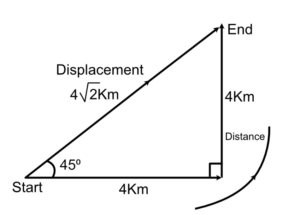Table of Contents
What is Distance?
Distance is the length of the physical path traversed by a body. Distance is a scalar physical quantity.
What is Displacement?
Displacement is the length of shortest path between start and end points. Displacement is a vector physical quantity and it points from start position to end position.
Let us take an example to understand it!
Problem 1
An ant started from one corner of a floor of a cubical room of side length 5m and walked on the floor. After some time, it was found at the diagonally opposite corner of the floor of the room. What is the displacement?
Solution:
Displacement = shortest distance between start and end positions = length of diagonal of the floor = √52 + √52 = 5√2m
The displacement vector of the ant points from start position to END position.
Notice we cannot say how much distance the ant covered. Because we do not know the path it took.
Distance
You go to your school from your home by car, covering 1 km on the road. After school, you go to market covering 1700 metres. You covered a total distance of 2.7 km. Here, as far as distance calculation is concerned, it is not at all important in which direction your car moved, or how many times it took turns. Direction is of no importance for distance calculation. There is no specific direction associated with 2.7 km.
Distance and displacement

Suppose you go straight towards east for a distance of 4 km, and then you take a turn by 90 degrees towards north and travel for 4 km. How far are you and in which direction are you relative to start position?
The adjacent diagram shows where you are finally (direction wise) relative to start position As you can see,
- You are shifted (displaced) by 4√2km from your start position along north-east. DISPLACEMENT = 4√2km along north-east.
- You travelled a path length 8 km. Distance = 8 km.
Difference between Distance and displacement
| Distance | Displacement |
| It is the length of path traversed by a body | It is the length of shortest distance between two points |
| It is a scalar quantity | It is a vector quantity. It points from start position to end position |
| Odometer measures distance | Displacement helps you to know where you are finally relative to initial position (shortest length and direction) |
| Fuel consumption of a vehicle is based on distance | In a game of snake and ladder, you start from 1 and when you win, you are at 100. Displacement of the dice is the shortest distance between 1 and 100. But we know while playing, the dice did not move along the straight line joining 1 and 100. It did many movements, before arriving at the box on which 100 is written. |
Problem 2
You go to market on a straight road for a length of 3 km and come back straight?
What is the distance and displacement?
Solution:
Displacement = shortest distance between start and end positions = zero (start and end positions coincide)
Distance = 2 x 3 km = 6km
FAQs on Distance and Displacement
Is displacement a vector quantity or a scalar?
Displacement is a vector quantity. It points from start position to end position.
When is displacement equal to distance?
When motion is restricted to a straight line without any turns.
When can displacement be greater than distance?
Displacement can never be greater than distance. It can only be less than or equal to distance.









